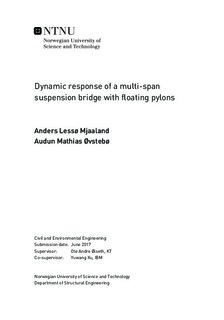Dynamic response of a multi-span suspension bridge with floating pylons
Master thesis
Permanent lenke
http://hdl.handle.net/11250/2455578Utgivelsesdato
2017Metadata
Vis full innførselSamlinger
Sammendrag
The Norwegian Public Roads Administration is currently investigating the possibility of crossing the 500 m deep and 5 km wide fjord, Bjørnafjorden, located in Norway. Several concepts have been developed on behalf of the Norwegian Public Roads Administration. A multi-span floating suspension bridge, with pylons resting on tension leg platforms, is considered in this thesis. A parametrized FE-model, which includes the hydrodynamic properties of the bridge, has been developed and used to obtain the standard deviations from a coupled buffeting and wave analysis, performed in modal coordinates in the frequency domain.
From the modal buffeting analyses, it is discovered that the wind loading is the dominating loading with respect to the STD compared to the wave loading. It is discovered that second order wave forces could be important for high-frequency response.
Load combinations with a 100 year return period are estimated by the contour surface method. The extreme short-term response and the extreme long-term response, based on the probability density function of the environmental loading, have been estimated and compared for lateral displacement at the middle of the central span. From the extreme value assessment, it is found that wind loading is the dominant contributor to the lateral displacement. Swell waves increase the extreme response by 15 %, while the contribution from wind waves are of little importance.
The motion induced instability, with empirical derived aerodynamic derivatives, is found to be a combination of the second vertical mode and the first torsional mode. The corresponding critical velocity is 85.09 m/s. In a parameter study of damage to different components of the bridge, it has been found that unsymmetrical top cable damage severely alters the vertical modes of the bridge.
For the further research and development of this bridge project, it is, in particular, recommended to develop a realistic probability distribution of the environmental conditions in the Bjørnafjorden area.
